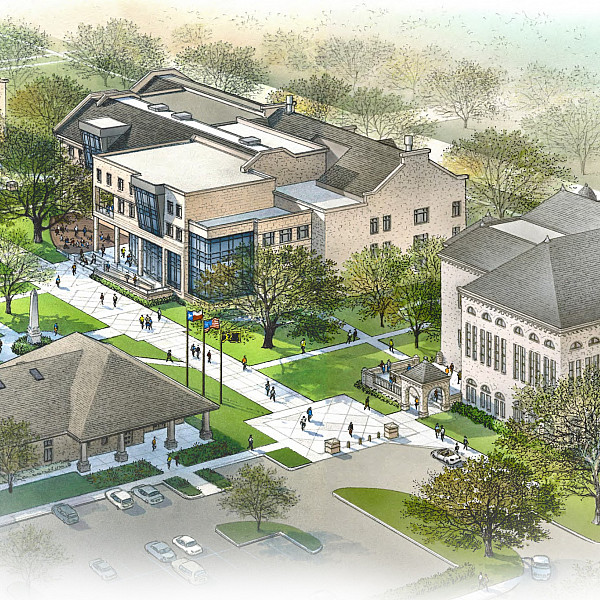News
Southwestern Officially Breaks Ground on Phase II of Fondren-Jones Science Center
February 02, 2018
February 02, 2018
Open gallery

On February 2, 2018, Southwestern University officially broke ground on the second phase of a $37 million-dollar expansion to the Fondren-Jones Science Center. The project is expected to be completed and ready to welcome students in the fall of 2019.
“Science today is an amalgamation of scientific disciplines all working in concert. The design of this building is just another example of our commitment to preparing students for this new scientific community through a truly interdisciplinary approach,” said Craig Erwin, Vice President for Finance and Administration at Southwestern.
Fondren-Jones Expansion, Phase I
Phase I, which added 25,000 sq ft of new space dedicated to teaching laboratories, student-faculty research space and collaborative learning studios, was completed in the fall of 2016. The updated wing supports teaching and research in biology, chemistry, biochemistry and physics.
Southwestern science students from these disciplines have benefited greatly from the Phase I updates, as the new wing was strategically build to encourage collaboration. The shared research labs allow more interaction between faculty and students and provide a better research experience for the students.
The addition also included a new, state-of-the art nuclear magnetic resonance imaging instrument used for identifying chemical structures. Other highlights from Phase I include a new molecular Biology Center and additional spaces with instrumentation and support for student-faculty research including a cell culture facility, imaging center, instrumentation rooms, and the new NMR.
Phase II
The second phase of the Science center expansion builds upon the interdisciplinary focus established during Phase I. This is crucial, explains Ben Pierce, Professor of Biology at Southwestern. “Science today is so intertwined, with different disciplines working together to develop solutions to major problems. The future of science no longer revolves around working in silos, but in collaborating across multiple areas.” He gave examples of health sciences, emerging diseases, environmental issues, and the aging population as just a few of the fields that cross disciplinary lines and benefit from collaboration. “The physical space of our science building is important to facilitating these working relationships and breaking down those silos. Phase II is intentionally designed to enhance the shared learning environment and encourage collaboration among both faculty and students.”
Phase II of the new Science Center will entail 58,000 square feet (20,000 square feet of new space and 38,000 square feet of renovated space) and include:
- 4 new classrooms
- 4 teaching laboratories
- 3 seminar/conference rooms
- 3 computer laboratories
- 2 outdoor teaching spaces
- 8 research laboratories, including 5 labs for future faculty
- 42 offices, including 8 offices for future faculty/staff
- Whitmore Mathematics/Computer Science Laboratory
- Premedical center
- Shop
- Kinesiology Human Performance Laboratory
- Plant growth facility
- Storage space for all departments
Phase II Objectives
The updated Science Center will not only bring aesthetic improvements to campus, but it will help the Sciences reach the following objectives:
Develop an Integrated Space
Phase II will finally unify the Science Center, which contains the original structure of 1952, an addition built in 1998, and the Phase I updates from 2016. “This will give us an integrated building that houses all of Southwestern’s science disciplines under one roof,” explains Pierce. Once complete, it will also include Kinesiology and Computer Science, two science majors that are currently located in other areas of campus. There will also be an atrium on the north front of the building to encourage students from all disciplines at Southwestern – not just the sciences – to study, hang out, have discussions and interact.
Sense of Community
With a collaborative learning studio on each floor, as well as other dedicated places for interaction, students will be encouraged to study and spend time interacting with other students as well as faculty members. They can pop in and study, work on projects or discuss concepts from class. Pierce believes these collaborative spaces are “as important as classrooms and labs, because they help create and promote the science community.” This synergy, social atmosphere and overall experience is important to retention.
Inquiry-Based Learning
Phase II will encourage inquiry-based learning, in which students learn through their own agency and investigation. Everything from the classroom setup, furniture (on wheels so it’s easily rearranged) and integrated AV equipment are designed for increased participation and interaction. Touch screens allow for easy sharing of data, and the setup allows for easier viewing from multiple areas.
Security and Accessibility
The updated technology and layout will ensure security, while also increasing accessibility to students. Science facilities depend upon deliveries of equipment, chemicals, and gases that will be separated from public entrances to the science center. The card access system will monitor and ensure security measures, but students will be able to access the building as needed – including on nights and weekends. Additionally, much of the high-end equipment that is often reserved for research students at other universities will be available and accessible to SU science students.















